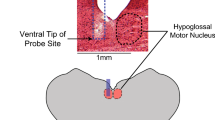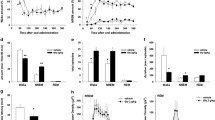Abstract
Clinical trials in obstructive sleep apnea syndrome patients reported moderate effects of serotoninergic drugs on oropharyngeal apneas, although numerous specific 5-HT ligands highly modulate the genioglossus muscle (GG) activity in experiments performed in anesthetized animals. The purpose of this study was to investigate time- and dose-related effects of central and systemic injections of 8-OHDPAT (5-HT1A agonist), SB224289 (5-HT1B antagonist), and DOI (5-HT2A/2C agonist) on the GG activity in anesthetized and conscious rats. Electromyographic recordings of the GG activity (GGemg) were analyzed after central and systemic injections of each drug in ketamine–xylazine anesthetized rats. Electroencephalograms (EEG), as well as neck and GG muscle activities (Nemg and GGemg), were recorded in 15 additional rats to analyze changes in sleep–wake states before and after systemic injection of the drugs. Central injections of 8-OHDPAT and DOI in anesthetized rats induced clear dose-related increases in phasic and tonic GGemg activities, respectively. The time-responses were inferior to 30 min with 8-OHDPAT and over 50 min with DOI. Moderate increases in phasic GGemg activity were also observed after central, but not peripheral injection of SB and DOI. The total sleep time measured in conscious rats significantly decreased after systemic injections of DOI and 8-OHDPAT, although no change was observed in phasic or tonic GGemg activity. The dose- and time-responses of the DOI in anesthetized rat partly explain the lack of GGemg tonic change in conscious rat. The moderate effect on the GGemg phasic activity of peripheral 5-HT1A ligand injection easily explains the lack of change in conscious rat. The serotonergic modulation of the respiratory component of the GGemg remains complex, but is highly sensitive to 5-HT1A receptors after central injection in rats under anesthesia. Forthcoming therapy in OSAS should be made of mixed profiled neurotransmitters and different routes of administration.






Similar content being viewed by others
References
Katz ES, White DP (2003) Genioglossus activity in children with obstructive sleep apnea during wakefulness and sleep onset. Am J Respir Crit Care Med 168(6):664–670
Krammer EB, Rath T, Lischka MF (1979) Somatotopic organization of the hypoglossal nucleus: a HRP study in the rat. Brain Res 170:533–537
Uemura-Sumi M, Itoh M, Mizuno N (1988) The distribution of hypoglossal motoneurons in the dog, rabbit and rat. Anat Embryol 177:389–394
Horner RL (2001) The neuropharmacology of upper airway motor control in the awake and asleep states: implications for obstructive sleep apnoea. Respir Res 2(5):286–294
Volgin DV, Fay R, Kubin L (2003) Postnatal development of serotonin 1B, 2 A and 2C receptors in brainstem motoneurons. Eur J Neurosci 17(6):1179–1188
Jacobs BL, Fornal CA (1999) Activity of serotonergic neurons in behaving animals. Neuropsychopharmacology 21(2):9S–15S
Manaker S, Tischler LJ (1993) Origin of serotoninergic afferents to the hypoglossal nucleus in the rat. J Comp Neurol 334(3):466–476
Kubin L, Reignier C, Tojima H, Taguchi O, Pack AI, Davies RO (1994) Changes in serotonin level in the hypoglossal nucleus region during carbachol-induced atonia. Brain Res 645(1–2):291–302
Richmonds CR, Hudgel DW (1996) Hypoglossal and phrenic motoneuron responses to serotonergic active agents in rats. Respir Physiol 106(2):153–160
Fenik P, Veasey SC (2003) Pharmacological characterization of serotonergic receptor activity in the hypoglossal nucleus. Am J Respir Crit Care Med 167(4):563–569
Ogasa T, Ray AD, Michlin CP, Farkas GA, Grant BJ, Magalang UJ (2004) Systemic administration of serotonin 2A/2C agonist improves upper airway stability in Zucker rats. Am J Respir Crit Care Med 170(7):804–810
Veasey SC (2003) Serotonin agonists and antagonists in obstructive sleep apnea: therapeutic potential. Am J Respir Medicine 2(1):21–29
Veasey SC, Fenik P, Panckeri K, Pack AI, Hendricks JC (1999) The effects of trazodone with l-tryptophan on sleep-disordered breathing in the English bulldog. Am J Respir Crit Care Med 160(5 Pt 1):1659–1667
Schmidt HS (1983) l-Tryptophan in the treatment of impaired respiration in sleep. Bull Eur Physiopathol Respir 19(6):625–629
Mendelson WB, Maczaj M, Holt J (1991) Buspirone administration to sleep apnea patients. J Clin Psychopharmacol 11(1):71–72
Hanzel DA, Proia NG, Hudgel DW (1991) Response of obstructive sleep apnea to fluoxetine and protriptyline. Chest 100(2):416–421
Kraiczi H, Hedner J, Dahlof P, Ejnell H, Carlson J (1999) Effect of serotonin uptake inhibition on breathing during sleep and daytime symptoms in obstructive sleep apnea. Sleep 22(1):61–67
Shen C, Li H, Meller E (2002) Repeated treatment with antidepressants differentially alters 5-HT1A agonist-stimulated [35S]GTP gamma S binding in rat brain regions. Neuropharmacology 42(8):1031–1038
Scott C, Soffin EM, Hill M, Atkinson PJ et al (2006) SB-649915, a novel, potent 5-HT1A and 5-HT1B autoreceptor antagonist and 5-HT re-uptake inhibitor in native tissue. Eur J Pharmacol 536(1–2):54–61
Jelev A, Sood S, Liu H, Nolan P, Horner RL (2001) Microdialysis perfusion of 5-HT into hypoglossal motor nucleus differentially modulates genioglossus activity across natural sleep-wake states in rats. J Physiol 532(Pt 2):467–481
Hilaire G, Duron B (1999) Maturation of the mammalian respiratory system. Physiol Rev 79(2):325–360
Carley DW, Depoortere H, Radulovacki M (2001) R-zacopride, a 5-HT3 antagonist/5-HT4 agonist, reduces sleep apneas in rats. Pharmacol Biochem Behav 69(1–2):283–289
Stradling J, Smith D, Radulovacki M, Carley D (2003) Effect of ondansetron on moderate obstructive sleep apnoea, a single night, placebo-controlled trial. J Sleep Res 12(2):169–170
Zhan G, Shaheen F, Mackiewicz M, Fenik P, Veasey SC (2002) Single cell laser dissection with molecular beacon polymerase chain reaction identifies 2A as the predominant serotonin receptor subtype in hypoglossal motoneurons. Neuroscience 113(1):145–154
Schwarzacher SW, Pestean A, Gunther S, Ballanyi K (2002) Serotonergic modulation of respiratory motoneurons and interneurons in brainstem slices of perinatal rats. Neuroscience 115(4):1247–1259
Lalley PM, Bischoff AM, Richter DW (1994a) Serotonin 1A-receptor activation suppresses respiratory apneusis in the cat. Neurosci Lett 172(1–2):59–62
Lalley PM, Bischoff AM, Richter DW (1994b) 5-HT-1A receptor-mediated modulation of medullary expiratory neurones in the cat. J Physiol 476(1):117–130
Okabe S, Kubin L (1996) Role of 5HT1 receptors in the control of hypoglossal motoneurons in vivo. Sleep 19(10):S150–S153
Okabe S, Mackiewicz M, Kubin L (1999) Serotonin receptor mRNA expression in the hypoglossal motor nucleus. Respir Physiol 110(2–3):151–160
Edwards E, Whitaker-Azmitia PM, Harkins K (1990) 5-HT1A and 5-HT1B agonists play a differential role on the respiratory frequency in rats. Neuropsychopharmacology 3(2):129–136
Holtman Jr JR, King KA (1994) Effect of activation of 5-HT1A receptors at the ventral medulla on phrenic nerve activity. Eur J Pharmacol 253(3):307–310
Monteau R, Morin D, Hennequin S, Hilaire G (1990) Differential effects of serotonin on respiratory activity of hypoglossal and cervical motoneurons: an in vitro study on the newborn rat. Neurosci Lett 111(1–2):127–132
Khater-Boidin J, Rose D, Glerant JC, Duron B (1999) Central effects of 5-HT on respiratory rhythm in newborn rats in vivo. Eur J Neurosci 11(10):3433–3440
Stone RA, Barnes PJ, Chung KF (1997) Effect of 5-HT1A receptor agonist, 8-OH-DPAT, on cough responses in the conscious guinea pig. Eur J Pharmacol 332(2):201–207
Messier ML, Li A, Nattie EE (2004) Inhibition of medullary raphe serotonergic neurons has age-dependent effects on the CO2 response in newborn piglets. J Appl Physiol 96(5):1909–1919
Haji A, Takeda R, Okazaki M (2000) Neuropharmacology of control of respiratory rhythm and pattern in mature mammals. Pharmacol Ther 86(3):277–304
Monti JM, Jantos H (1994) Stereoselective antagonism by pindolol enantiomers of 8-OHDPAT-induced changes of sleep and wakefulness. Neuropharmacology 33:705–708
Carley DW, Radulovacki M (1999) Mirtazapine, a mixed-profile serotonin agonist/antagonist, suppresses sleep apnea in the rat. Am J Respir Crit Care Med 160:1824–1829
Millhorn DE, Eldridge FL, Waldrop TG, Klingler LE (1983) Centrally and peripherally administered 5-HTP have opposite effects on respiration. Brain Res 264(2):349–354
Monti JM, Jantos H (2003) Differential effects of the 5-HT1A receptor agonist flesinoxan given locally or systemically on REM sleep in the rat. Eur J Pharmacol 478(2–3):121–130
Bjorvatn B, Ursin R (1998) Changes in sleep and wakefulness following 5-HT1A ligands given systemically and locally in different brain regions. Rev Neurosci 9(4):265–273
Hannon J, Hoyer D (2002) Serotonin receptors and systems: endless diversity. Acta Biol Szegediensis 46(1–2):1–12
Teng YD, Bingaman M, Taveira-DaSilva AM, Pace PP, Gillis RA, Wrathall JR (2003) Serotonin 1A receptor agonists reverse respiratory abnormalities in spinal cord-injured rats. J Neurosci 23(10):4182–4189
Choi H, Liao WL, Newton KM et al (2005) Respiratory abnormalities resulting from midcervical spinal cord injury and their reversal by serotonin 1A agonists in conscious rats. J Neurosci 25(18):4550–4559
Richter DW, Manzke T, Wilken B, Ponimaskin E (2003) Serotonin receptors: guardians of stable breathing. Trends Mol Med 9(12):542–548
Blier P, de Montigny C (1990) Electrophysiological investigation of the adaptive response of the 5-HT system to the administration of 5-HT1A receptor agonists. J Cardiovasc Pharmacol 15(7):S42–S48
Rose D, Khater-Boidin J, Toussaint P, Duron B (1995) Central effects of 5-HT on respiratory and hypoglossal activities in the adult cat. Respir Physiol 101(1):59–69
Freo U, Soncrant TT, Holloway HW, Rapoport SI (1991) Dose- and time-dependent effects of 1-(2,5-dimethoxy-4-iodophenyl)-2-aminopropane (DOI), a serotonergic 5-HT2 receptor agonist, on local cerebral glucose metabolism in awake rats. Brain Res 541(1):63–69
Kubin L, Tojima H, Reignier C, Pack AI, Davies RO (1996) Interaction of serotonergic excitatory drive to hypoglossal motoneurons with carbachol-induced, REM sleep-like atonia. Sleep 19(3):187–195
Fenik VB, Davies RO, Kubin L (2005) Noradrenergic, serotonergic and GABAergic antagonists injected together into the XII nucleus abolish the REM sleep-like depression of hypoglossal motoneuronal activity. J Sleep Res 14(4):419–429
Sood S, Morrison JL, Liu H, Horner RL (2005) Role of endogenous serotonin in modulating genioglossus muscle activity in awake and sleeping rats. Am J Respir Crit Care Med 172(10):1338–1347
Sood S, Raddatz E, Liu X, Liu H, Horner RL (2006) Inhibition of serotonergic medullary raphe obscurus neurons suppresses genioglossus and diaphragm activities in anesthetized but not conscious rats. J Appl Physiol 100(6):1807–1821
Chan E, Steenland HW, Liu H, Horner RL (2006) Endogenous excitatory drive modulating respiratory muscle activity across sleep–wake states. Am J Respir Crit Care Med 174:1264–1273
Steenland HW, Liu H, Sood S, Liu X, Horner RL (2006) Respiratory activation of the genioglossus muscle involves both non-NMDA and NMDA glutamate receptors at the hypoglossal motor nucleus in vivo. Neuroscience 138(4):1407–1424
Billiard M, Partinen M, Roth T, Shapiro C (1994) Sleep and psychiatric disorders. J Psychosom Res 38 (1):1–2
Paxinos G, Watson C (1986) The rat brain in stereotoxic coordinates, 2nd ed. New York Academic Press
Acknowledgments
The authors thank Dr. Adèle Ottavi and Me Mathilde Beslier for their help in the manuscript preparation. This study was supported by a grant from Sanofi-Aventis (sleep research award “Veille-Sommeil” French Sleep Research Society Congress SFRS, Paris, France 2003).
Author information
Authors and Affiliations
Corresponding author
Rights and permissions
About this article
Cite this article
Besnard, S., Massé, F., Verdaguer, M. et al. Time- and dose-related effects of three 5-HT receptor ligands on the genioglossus activity in anesthetized and conscious rats. Sleep Breath 11, 275–284 (2007). https://doi.org/10.1007/s11325-007-0107-0
Published:
Issue Date:
DOI: https://doi.org/10.1007/s11325-007-0107-0




